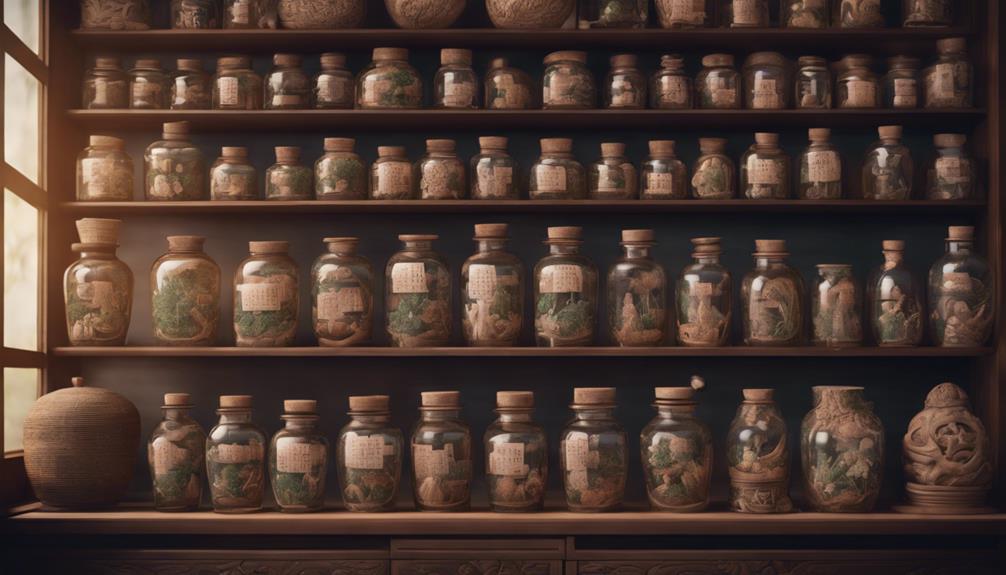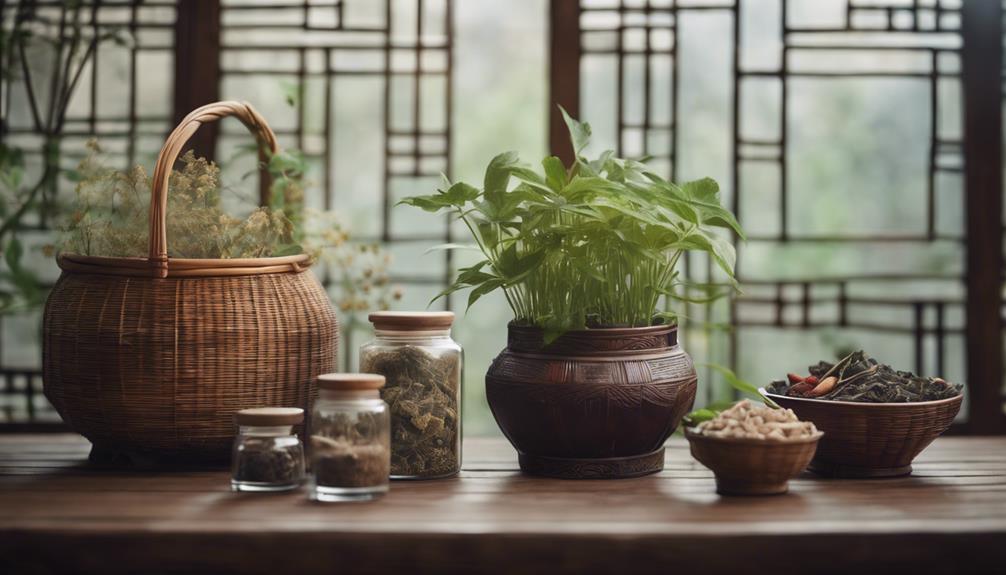We explore Chinese herbology, a sophisticated system of traditional medicine that has evolved over centuries, rooted in a rich heritage of philosophical and cultural influences. This ancient practice, dating back to around 2800 BCE, emphasizes the importance of balancing yin and yang elements for health and well-being. Chinese herbs are categorized based on their properties, such as Four Natures and Five Flavors, and are used to create targeted formulas addressing specific health concerns. As we examine the principles, classification, preparation, and uses of Chinese herbs, we'll uncover the intricacies of this nuanced system, and discover how it continues to shape modern medicine.
Key Takeaways
• Chinese herbology is a sophisticated system of traditional medicine with a history dating back to 2800 BCE, rooted in ancient heritage.
• The principles of yin and yang are crucial, as balancing these opposing forces is essential for health and well-being.
• Herbs are classified based on Four Natures, Five Flavors, and energetic properties, and are associated with specific meridians in the body.
• Chinese herbal formulas target specific health concerns, aiming to restore balance and harmony by combining multiple ingredients in decoctions.
• Safety concerns, including toxic compounds and ecological impact, must be addressed to ensure the safe use of Chinese herbal medicine.
History of Chinese Herbology
As we investigate the rich history of Chinese herbology, we find ourselves tracing the roots of this ancient practice back to Shen Nong, the legendary first herbalist, who around 2800 BCE, boldly tasted hundreds of herbs to uncover their medicinal properties. This pioneering spirit laid the foundation for a thorough understanding of Chinese herbs and their therapeutic applications.
Shen Nong's groundbreaking work categorized herbs into three groups: superior, middle, and inferior substances, setting a precedent for future generations of herbalists. Fast-forward to the Ming Dynasty, and we find Li Shizhen's monumental work, the Compendium of Materia Medica, which remains a seminal reference in the field. This exhaustive tome catalogs over 13,000 medicinals and 100,000 herbal recipes, cementing Chinese herbology's reputation as a sophisticated and nuanced system of traditional medicine.
Through the centuries, Chinese herbology has evolved, incorporating new knowledge and techniques while remaining rooted in its ancient heritage. As we explore further into this fascinating subject, we'll examine the principles, practices, and applications of this timeless tradition.
Principles of Yin and Yang

As we explore the principles of yin and yang, we'll examine how these fundamental concepts shape our understanding of Chinese herbology.
We'll discuss how balancing the elements, recognizing yin-yang interdependence, and aiming for universal harmony are essential to achieving harmony in the natural world and within ourselves.
Balancing the Elements
We explore the heart of Chinese herbology, where the ancient concept of yin and yang plays a pivotal role in maintaining harmony and balance in the body.
In traditional Chinese medicine, the balance of yin and yang is essential for health and well-being. This balance is achieved by harmonizing the opposing forces of yin, symbolizing the female/passive/negative principle, and yang, representing the male/active/positive principle.
The taijitu symbol, commonly known as the yin yang symbol, visually represents the interplay and balance between these opposing forces. By understanding and applying the principles of yin and yang in Chinese herbal medicine, we can maintain balance and promote holistic health.
This balance is vital for the body's natural healing process, as it allows the body to respond to changes and adapt to its environment. In Chinese herbology, balancing the elements through the principles of yin and yang helps to restore harmony and promote overall well-being.
Yin-Yang Interdependence
By exploring the principles of yin and yang, we gain insight into the intricate dance of opposing forces that shape the natural world and our own bodily harmony.
In traditional Chinese medicine (TCM), yin and yang represent opposing but interdependent forces that must be balanced for best health. Yin symbolizes the female, passive, and negative qualities, while yang represents the male, active, and positive aspects.
The taijitu symbol, commonly known as the yin-yang symbol, visually represents the dynamic interplay between yin and yang. This ancient concept is rooted in the I Ching, an ancient Chinese text, where yin and yang are symbolized by broken and solid lines, reflecting the concept of duality and balance.
As we explore the principles of yin and yang, we begin to understand the delicate balance required to maintain harmony in nature and human health. By recognizing the interdependence of yin and yang, we can better appreciate the intricate web of relationships that govern our world and our bodies.
Universal Harmony
Embracing the principles of yin and yang, we unveil the secret to universal harmony, where opposing forces converge to create a delicate balance that sustains life and promotes well-being.
In traditional Chinese medicine, the balance of yin and yang is essential for health and harmony. We comprehend that yin symbolizes the feminine, passive, and negative aspects, while yang represents the masculine, active, and positive qualities.
The taijitu symbol beautifully illustrates the interplay between yin and yang, emphasizing their constant interaction and transformation. By grasping the principles of yin and yang, we can diagnose and treat illnesses by restoring the balance of energies in the body. This understanding allows us to address the root causes of diseases, rather than just their symptoms.
As we explore further into the principles of yin and yang, we uncover the intricate web of relationships that govern the natural world. By embracing this delicate balance, we can reveal the secrets of universal harmony, promoting health, well-being, and a deeper connection with the world around us.
Classification of Chinese Herbs

As we explore the classification of Chinese herbs, we'll examine the properties of herbs, herbal action types, and energetic classification. These aspects are essential in understanding how Chinese herbs interact with the body and how they're combined to create effective remedies.
Properties of Herbs
Classifying Chinese herbs according to their properties is essential in traditional Chinese medicine, as it enables practitioners to harness their therapeutic potential.
We've found that Chinese herbs are classified based on their Four Natures (hot, warm, cool, cold) and Five Flavors (sour, bitter, sweet, pungent, salty).
Each herb is associated with specific meridians in the body according to traditional Chinese medicine principles. The properties of Chinese herbs determine their therapeutic actions and functions in treating various health conditions.
For instance, herbs with a cooling nature can help reduce fever, while those with a warming nature can alleviate digestive issues. Understanding the Four Natures and Five Flavors of herbs allows practitioners to create effective formulations that address specific health concerns.
Additionally, recognizing the potential toxicity of certain herbs is vital, as it requires careful consideration and expertise in their preparation and dosage.
Herbal Action Types
We categorize Chinese herbs into distinct action types, including warming, cooling, and tonic herbs, to understand their therapeutic effects and create balanced formulas for specific health concerns. These herbal action types help us grasp the unique properties of each Chinese herb, allowing us to craft targeted remedies for various health issues.
Warming herbs, such as ginger and cinnamon, increase body heat and circulation, making them ideal for alleviating cold-related conditions. On the other hand, cooling herbs like mint and chrysanthemum clear heat and reduce inflammation, making them suitable for hot or feverish conditions.
Tonic herbs, including ginseng and astragalus, strengthen the body and promote overall health. By understanding the action types of Chinese herbs, we can create balanced formulas that address specific health concerns. This classification system enables us to harness the therapeutic potential of Chinese herbs, ensuring that we create effective remedies that address the unique needs of each individual.
Energetic Classification
In traditional Chinese medicine, we rely on the energetic classification of herbs to pinpoint their effects on the body's delicate yin-yang balance. This fundamental principle guides our diagnosis and treatment strategies.
Chinese herbs are categorized based on their energetic properties, which can be hot, warm, cool, cold, or neutral. This classification is essential, as it determines the herb's impact on the body's energy balance.
We use hot herbs to treat conditions associated with coldness, while cold herbs are used for heat-related conditions. For instance, a hot herb like ginger might be used to warm the body and alleviate digestive issues, while a cold herb like mint might be used to cool the body and reduce fever.
Preparation and Extraction Methods

When preparing Chinese herbal remedies, we carefully select and combine multiple ingredients to create complex formulas that target specific health concerns. In Chinese herbology, preparation methods are essential in harnessing the therapeutic potential of medicinal substances.
Decoctions, for instance, typically consist of 9 to 18 substances, with a clear distinction between main and ancillary herbs.
To guarantee consistent quality and potency, modern teapills are extracted in stainless steel extractors. Additionally, medicinal substances are condensed and mixed with raw herb powder to create effective and concentrated herbal remedies.
We use various extraction methods to create Chinese patent medicines, which are standardized herbal formulas processed into convenient pill forms for easy consumption.
Some common extraction methods include:
- Solvent extraction using water or ethanol
- Steam distillation to isolate volatile compounds
- Cold pressing to extract oils and essences
Therapeutic Functions and Uses

Chinese herbs have been used for centuries to treat a wide range of health conditions, from alleviating pain and digestive issues to addressing respiratory ailments. In traditional Chinese herbal medicine, different herbs are categorized based on their therapeutic functions, such as clearing heat, tonifying Qi, or promoting blood circulation. These functions are essential in understanding how Chinese herbal formulas work.
| Therapeutic Function | Example Herbs |
|---|---|
| Clearing Heat | Coptis, Scute |
| Tonifying Qi | Ginseng, Astragalus |
| Promoting Blood Circulation | Salvia, Safflower |
We use Chinese herbal formulas to enhance efficacy and target specific health concerns. Our approach in traditional Chinese medicine aims to restore balance and harmony within the body to promote overall well-being. Based on individualized diagnoses and treatment plans, we select herbs that address unique health needs. By understanding the therapeutic functions of Chinese herbs, we can fully leverage their potential in promoting health and wellness.
Safety and Toxicity Concerns

We frequently encounter concerns about the safety and toxicity of traditional Chinese herbal medicines, which can be contaminated with harmful substances or manufactured under questionable quality control practices. This raises serious safety concerns, as some traditional Chinese herbal medicines have been found to be contaminated with toxic compounds, heavy metals, and pesticides.
Moreover, improper manufacturing practices and a lack of quality control can lead to the presence of harmful substances in these medicines. For instance:
- Contamination with toxic compounds, heavy metals, and pesticides
- Presence of harmful substances due to improper manufacturing practices
- Lack of quality control, leading to inconsistent product quality
It is imperative to address these concerns to ensure the safe use of traditional Chinese herbal medicine. By doing so, we can promote the responsible use of these medicines and minimize potential harm to consumers.
Ecological Impact and Sustainability

As we consider the responsible use of traditional Chinese herbal medicine, it's alarming to find that some of its practices have a darker side, threatening the very fabric of our ecosystem.
The ecological impact of TCM is a pressing concern, particularly when it comes to wildlife conservation. The use of endangered species, such as tiger bones and rhinoceros horn, contributes to their decline and even extinction.
Additionally, the harvesting of turtle plastron and seahorses has raised concerns about overexploitation and potential species decline. Similarly, the extraction of bear bile for TCM results in inhumane conditions for Asiatic black bears and poses a threat to their populations.
Moreover, the harvesting of American ginseng for Asian traditional medicine raises concerns about the sustainability of wild plant populations. It's crucial to acknowledge these ecological concerns and work towards sustainable practices that ensure the long-term survival of these species.
Notable Herbalists and Their Contributions

In the rich tapestry of traditional Chinese herbal medicine, Shen Nong stands out as a pioneering figure, credited with being the first herbalist around 2800 BCE. His contributions to Chinese Materia Medica, a foundational text in traditional Chinese medicine (TCM), are still revered today. Shen Nong's work classified herbs into three categories based on their effects, laying the groundwork for future generations of herbalists.
Other notable herbalists have made significant contributions to the field. For instance, Li Shizhen's Compendium of Materia Medica, completed in 1590, is still a valuable resource for Chinese herbology. This extensive text records over 13,000 medicinals and 100,000 recipes, showcasing the vast scope of traditional Chinese medicine.
Some key aspects of traditional Chinese herbology include:
- The use of plant elements, with some formulations incorporating animal parts and minerals
- A focus on balancing the body's energy, or 'qi'
- A long history of recorded knowledge, with texts like Li Shizhen's Compendium still studied today
Modern Applications and Research

Building on the foundations laid by pioneers like Shen Nong and Li Shizhen, modern research has propelled traditional Chinese herbal medicine into the spotlight, with scientists now exploring its applications in treating a range of modern health concerns.
We're seeing a surge in clinical trials examining the effectiveness of Chinese herbal medicine in combating hepatitis B, a condition that has shown significant improvement with its use.
Additionally, research has investigated the neurobiological effects of Chinese herbal medicine on neurological disorders, such as dementia and insomnia, with promising results. Formulas like DX-9386 and ZiBuPiYin have been developed to tackle various neurological disorders.
The scope of Chinese herbal medicine's applications is vast, with studies investigating its potential in treating Wilson Disease and dermatologic diseases.
As we continue to uncover the potential of this ancient practice, we're reminded of the importance of continued research and exploration. By doing so, we can reveal the full potential of Chinese herbal medicine and its role in modern healthcare.
Frequently Asked Questions
What Are the 4 Pillars of Chinese Herbalism?
We're often asked, what're the 4 pillars of Chinese herbalism? Well, we're here to clarify.
The four pillars are:
- Diagnosis
- Treatment principles
- Herbal formulas
- Modifications
To sum up, diagnosis involves identifying patterns of disharmony, treatment principles guide herb selection, herbal formulas are tailored to individual needs, and modifications are adjustments made based on a patient's response to treatment.
These pillars work together to provide a holistic approach to health and wellness.
Does Chinese Herbal Medicine Actually Work?
We've all wondered: does Chinese herbal medicine really work? Research suggests that while some studies show promise, the evidence is often mixed and inconclusive.
For instance, real acupuncture may help with chronic pain, and tai chi has benefits for balance and pain relief. However, the effectiveness of Chinese herbal products remains uncertain, and we should consult healthcare providers before using them, not replacing conventional care without professional advice.
What Are the Four Natures of Chinese Medicine?
We're delving into the Four Natures of Chinese medicine, which categorize herbs as cold, cool, warm, or hot based on their effects on the body.
This classification system is vital in determining how herbs interact with the body's yin and yang balance.
What Are the Disadvantages of Chinese Herbalism?
We're stuck between a rock and a hard place when it comes to Chinese herbalism.
On one hand, it's an ancient practice with potential benefits.
On the other, we've got some major drawbacks to ponder.
For starters, contamination with heavy metals and pesticides is a real concern.
Manufacturing errors can lead to serious complications, and quality control issues have raised safety flags.
Conclusion
As we conclude our exploration of Chinese herbology, let's consider a powerful example: a 50-year-old woman with chronic arthritis finds relief from a custom-blended herbal remedy, experiencing reduced inflammation and improved mobility.
This illustration highlights the potential of Chinese herbology to address complex health issues. By grasping the principles, classification, and therapeutic functions of Chinese herbs, we can tap into the full potential of this ancient practice, integrating it with modern medicine for a more holistic approach to healthcare.










